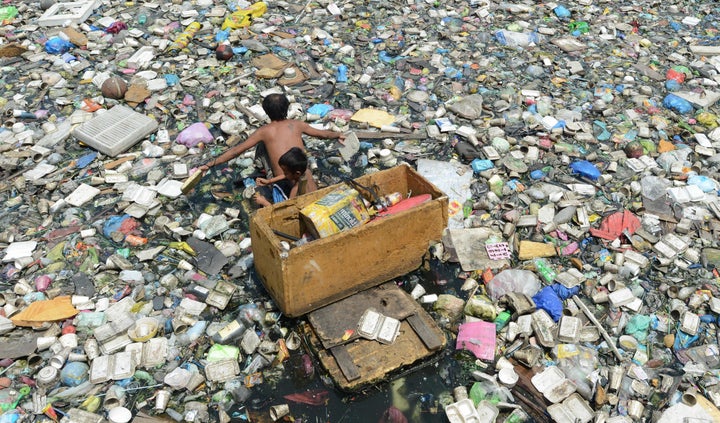
Jack-o’-lantern season is here, and if you have $23.49 to spare you could always get yourself a styrofoam pumpkin from Walmart to truly bring the horror of Halloween to life. You’ll need to be fast though; the orange version has already sold out online.
Fake pumpkins seem to be everywhere. Dollar Tree has a styrofoam range that you can “cut, carve, paint, and add props to.” And Target is offering an $8 carve-your-own plastic pumpkin with “highlights” including its compatibility with most pumpkin carving kits.
Truth is, there’s something else that fits these descriptions: a natural pumpkin.
A natural pumpkin also has the advantage of being biodegradable. In contrast, the plastic many of these fake pumpkins are made from ― a form of foamed polystyrene ― can take up to a million years to decompose. It has a very low recycling rate with most ending up dumped, where it fragments into smaller pieces that pollute our oceans and are ingested by wildlife.

So why are these retailers doing it?
Target’s website says its fake pumpkin (which is made from polyurethane, another material that’s hard to break down) “eliminates the mess that comes with traditional pumpkin carving.” But the messiness is a part of Halloween, said Michael O’Heaney, executive director of environmental campaign group The Story of Stuff.
“There’s something special about going with your kid to a pumpkin patch, selecting your particular one from the hundreds if not thousands of pumpkins there, then taking it home and carving it up,” he told HuffPost. “The idea of taking a giant plastic pumpkin look-alike and carving it because it’s ‘a whole lot easier’ ― that takes away the charm and pleasure of it all. These fake pumpkins are ridiculous.”
But for O’Heaney, the much bigger concern is the harm the pumpkins pose to the environment.
“Plastic pumpkins, like so much other plastic waste, will likely end up in a landfill, burned in an incinerator or in the oceans,” he said. “There’s this idea that the plastic in our environment just ended up there somehow but, actually, plastic pollution is a huge, systemic problem caused in large part by big companies not taking responsibility. We need companies to get serious about plastic pollution; putting Styrofoam pumpkins on the shelves is the exact opposite of getting serious.”
These plastic pumpkins aren’t the only example of companies not getting serious. There are coconuts whose shells have been removed, only to be wrapped in plastic; there are egg cubers for when you really can’t face another oval egg; there are single-use, disposable cellphone chargers; and there’s a limited-edition fork designed to trigger a smartphone to play a recording when it detects the sound of noodle slurping so as to mask users’ food noises.
Environmental journalist George Monbiot has coined a term for these kinds of new, pointless items that simply serve to use up precious resources: “extreme civilisation.” Visit hashtag #extremecivilisation and see a constant stream of posts pointing to useless, wasteful products, from wine for cats and dogs to a novelty pimple-popping toy. It all highlights the gap between the public desire to address environmental destruction and the detrimental actions companies are taking, said O’Heaney, along with governments’ slow response to the severity of the problem.
It’s not just niche gadgets and seasonal novelty items that are unnecessary, said Nick Mallos, director of the Trash Free Seas program at environmental advocacy group Ocean Conservancy. There are lots of everyday items out there that we simply have no justification for, including microbeads in cosmetics and polystyrene food containers. You might think a carve-your-own plastic pumpkin is outrageous but, when you think about it, your single-use shopping bag is hardly better.
We’re being sold the idea of convenience, said environmental author and journalist Alan Weisman, even when the reality of what we’re buying ― like the coconut wrapped in plastic ― is no more convenient than whatever we had before.
“When you throw away that unnecessary plastic wrapper or dump a fake pumpkin that’s lost its charm, we don’t see the reality of it all ― the mining or drilling that’s gone into the energy it takes to make it, the transportation of it to our local store, the disposal of it to some tip that you probably don’t even know exists, or off onto a barge that then gets shipped abroad,” he said.
Weisman noted the true cost of our resource consumption over the past 50 years is now coming back to bite us.

“When the alarm went off in the 1970s that we were running out of resources, the purveyors of products made from those resources didn’t respond by turning to conservation. Quite the opposite,” he said. “They wanted to grab all they could while it lasted, going farther and digging deeper and mining more and harvesting and shipping faster than ever before. Their aim? To create an illusion of abundance that has yet to wane.”
Today, the effects of this ecological exhaustion are stark: Nearly 90 percent of the world’s marine fish stocks are now fully exploited, overexploited or depleted; 9 out of 10 people worldwide breathe polluted air; forests, including precious wildlife habitats, have been ravaged to produce commodities like palm oil for snacks and cosmetics; and drinking water has been contaminated with everything from arsenic to mercury.
As the stuff we consume is depleted at ever faster rates, said Weisman, we’re going to ever greater extremes to get it, “hence squeezing oil out of the tar sands of Alberta.”
Until we stop measuring economic health by whether our economy is growing, he concluded, we aren’t going to be able to fix this.
“We can’t keep growing indefinitely on a planet that does not grow, something’s gotta give,” he said. “And now, these days, everything is giving ― the atmosphere itself is giving.”
For more content and to be part of the “This New World” community, follow our Facebook page.
HuffPost’s “This New World” series is funded by Partners for a New Economy and the Kendeda Fund. All content is editorially independent, with no influence or input from the foundations. If you have an idea or tip for the editorial series, send an email to thisnewworld@huffpost.com.
